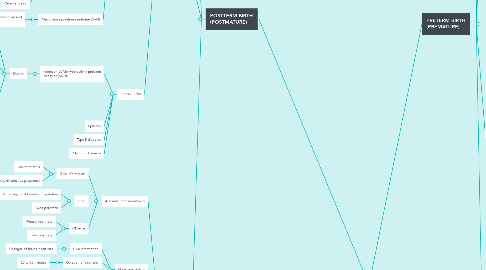
1. FULL-TERM BIRTH
1.1. DEFINITION
1.1.1. Born between 37 to 42 weeks
1.2. CHARACTERISTICS
1.2.1. Skin
1.2.1.1. Covered with cheese-like vernix in folds and crevices
1.2.1.2. Spot of blood
1.2.1.3. Bruises
1.2.1.4. Scratches
1.2.1.5. Skin-discoloration
1.2.2. Head
1.2.2.1. Elongated
1.2.2.2. Lopsided
1.2.2.3. Misshapes
1.2.3. Ears
1.2.3.1. Folded
1.2.3.2. Creased
1.2.4. Eyes
1.2.4.1. Swelling
1.2.4.2. Reddish in the white part of eye
1.2.5. Skull
1.2.5.1. Soft and pliable
1.2.5.2. Separated pieces of cartilage
1.2.6. Genitalia
1.2.6.1. Swollen
1.2.7. Hands and feet
1.2.7.1. Bluish
1.3. IMPORTANCE
1.3.1. Full development
1.3.1.1. Brain
1.3.1.2. Lungs
1.3.1.3. Liver
1.3.1.4. Muscle
1.3.2. Reduce
1.3.2.1. Vision and hearing problems
1.3.2.2. Breathing problems
1.3.2.3. Jaundice problems
1.3.2.4. Low blood sugar problems
1.3.2.5. Bleeding for mom
1.3.2.6. Risk of C-section
1.3.3. Gain sufficient weight
1.3.4. Able to suck, swallow
1.3.4.1. Ease breastfeeding
2. POSTTERM BIRTH (POSTMATURE)
2.1. DEFINITION
2.1.1. Born after 42 weeks
2.1.2. Other terms
2.1.2.1. Postdatism
2.2. RISK FACTORS
2.2.1. Previous postterm pregnancies
2.2.2. Maternal obesity
2.2.3. First pregnancy
2.2.4. Aging of placenta
2.2.5. Sulfatase deficiency in placenta
2.2.6. Anencephaly
2.2.7. Drying of amniotic fluid
2.3. CHARACTERISTICS
2.3.1. Skin-dry, loose and peeling
2.3.2. Nails-overgrown
2.3.3. Hair-large amount on head
2.3.4. Palms and feet-visible creases
2.3.5. Little body fat
2.3.6. More alert and ''wide-eyed''
2.4. CONSEQUENCES
2.4.1. SHORT TERM
2.4.1.1. Increase mortality rate (first year of life)
2.4.1.2. Dysmaturity syndrome
2.4.1.2.1. Stop gaining weight
2.4.1.2.2. Distinctive appearance
2.4.1.3. Fetal macrosomia (large baby)
2.4.1.3.1. Larger than average
2.4.1.3.2. May develop
2.4.1.4. Low umbilical artery pH levels (during delivery)
2.4.1.4.1. Acidic blood
2.4.1.4.2. May develop
2.4.1.5. Asphyxia
2.4.1.5.1. Lack of oxygen to brain
2.4.1.5.2. May develop
2.4.1.6. Meconium aspiration syndrome (MAS)
2.4.1.6.1. Inhalation mixture of meconium and amniotic fluid
2.4.2. LONG TERM
2.4.2.1. Attention defcit/hyperactivity problem behavior (ADHD)
2.4.2.1.1. Due to
2.4.2.2. Epilepsy
2.4.2.3. Type II diabetes
2.4.2.4. Childhood obesity
2.5. INTERVENTION
2.5.1. Antenatal fetal monitoring
2.5.1.1. Give information
2.5.1.1.1. Health of fetus
2.5.1.1.2. Risks of continue pregnancy
2.5.1.2. Time
2.5.1.2.1. At or beyond 41 weeks of gestation
2.5.1.2.2. Twice per week
2.5.1.3. Observe
2.5.1.3.1. Fetus's heart rate
2.5.1.3.2. Fetus's activity
2.5.2. Nonstress testing
2.5.2.1. Give information
2.5.2.1.1. Changes of fetus's heart rate
2.5.2.2. Duration of each test
2.5.2.2.1. 20 to 30 minutes
2.5.2.3. Observe
2.5.2.3.1. Normal heart rate of fetus
2.5.2.3.2. Increase of heart rate from baseline
2.5.3. Biophysical profile
2.5.3.1. Give information
2.5.3.1.1. Health of fetus
2.5.3.2. Components
2.5.3.2.1. Nonstress testing
2.5.3.2.2. Fetal body movements
2.5.3.2.3. Breathing movements
2.5.3.2.4. Fetal tone
2.5.3.2.5. Amniotic fluid volume
2.5.4. Inducing labor
2.5.4.1. Time
2.5.4.1.1. No sign of labor after 42 weeks of gestation
2.5.4.2. Administration of medication
2.5.4.2.1. Directly to cervix/vagina
2.5.4.2.2. By mouth
2.5.4.2.3. Intravenous
3. PRETERM BIRTH (PREMATURE)
3.1. DEFINITION
3.1.1. Born before 37 weeks
3.1.2. Subcategories
3.1.2.1. Exteremely preterm
3.1.2.1.1. Born before 28 weeks
3.1.2.2. Very preterm
3.1.2.2.1. Born between 28 to 32 weeks
3.1.2.3. Moderate to late preterm
3.1.2.3.1. Born between 32 to 37 weeks
3.1.3. Other terms
3.1.3.1. Preemie
3.2. RISK FACTORS
3.2.1. Previous premature birth
3.2.2. Chronic disease
3.2.2.1. Heart disease
3.2.2.2. Kidney disease
3.2.2.3. Diabetes
3.2.3. Infections
3.2.3.1. Group B streptococcus
3.2.3.2. Urinary tract infections
3.2.3.3. Vaginal infections
3.2.4. Drug/alcohol abuse
3.2.5. Cigarette smoking
3.2.6. Multiple pregnancies
3.2.7. Pregnancy gap <6 months
3.2.8. Underweight/overweight before pregnant
3.2.9. Inadequate prenatal care
3.2.10. Low socioeconomic status
3.2.11. Poor nutritional status
3.2.12. Premature opening of cervix
3.2.13. Fetal malformations
3.2.14. Premature rupture of amniotic sac
3.2.15. Unusual physical and psychological stress
3.3. CHARACTERISTICS
3.3.1. Skin-thin and transparent
3.3.2. Ears-wrinkle and lie flat
3.3.3. Nipples-barely visible
3.3.4. Genitals-swollen and underdeveloped
3.3.5. Head-large
3.3.6. Abdomen-large
3.3.7. Limbs-floppy and very limp
3.3.8. Appearance-scrawny and wrinkle
3.3.9. Hair-less scalp hair, lots of lanugo
3.3.10. Weight-often less than 2500g
3.3.11. Muscle-low muscle tone
3.3.12. Little body fat
3.4. CONSEQUENCES
3.4.1. SHORT TERM
3.4.1.1. Breathing problems
3.4.1.1.1. Respiratory distress syndrome
3.4.1.1.2. Bronchopulmonary dysplasia
3.4.1.1.3. Apnea
3.4.1.2. Heart problems
3.4.1.2.1. Patent ductus arteriosus (PDA)
3.4.1.2.2. Low blood pressure (hypotension)
3.4.1.3. Brain problems
3.4.1.3.1. Intraventricular hemorrhage
3.4.1.4. Temperature control problems
3.4.1.4.1. Hypothermia
3.4.1.5. Gastrointestinal problems
3.4.1.5.1. Necrotizing Enterocolitis (NEC)
3.4.1.6. Blood problems
3.4.1.6.1. Anemia
3.4.1.6.2. Newborn jaundice
3.4.1.7. Metabolism problems
3.4.1.7.1. Hypoglycemia
3.4.1.8. Immune system problems
3.4.1.8.1. Infection
3.4.2. LONG TERM
3.4.2.1. Cerebral palsy
3.4.2.1.1. Disorder of movement, muscle tone/posture
3.4.2.1.2. Cause
3.4.2.2. Impaired learning
3.4.2.3. Vision problems
3.4.2.3.1. Retinopathy
3.4.2.4. Hearing problems
3.4.2.5. Dental problems
3.4.2.5.1. Delayed tooth eruption
3.4.2.5.2. Tooth discoloration
3.4.2.5.3. Improperly aligned teeth
3.4.2.6. Behavioral & psychological problems
3.4.2.6.1. Developmental delay
3.4.2.7. Chronic health issues
3.4.2.7.1. Infections
3.4.2.7.2. Asthma
3.4.2.7.3. Feeding problems
3.4.2.7.4. Sudden death syndrome (SIDS)
3.5. INTERVENTION
3.5.1. Prenatal corticosteroid therapy to mom
3.5.1.1. Time
3.5.1.1.1. At least 48 hrs before preterm delivery
3.5.1.1.2. Between 24 to 34 weeks of gestation
3.5.1.2. Benefits
3.5.1.2.1. Reduce respiratory disease in baby
3.5.1.2.2. Reduce intraventricular hemorrhage
3.5.1.2.3. Reduce NEC and PDA
3.5.2. Placed in incubator
3.5.2.1. To keep baby warm
3.5.2.2. Maintain normal body temperature
3.5.3. Kangaroo care
3.5.3.1. Skin-to-skin contact with parent
3.5.3.2. Provide parent-infant attachment
3.5.4. Monitor vital signs
3.5.4.1. Blood pressure
3.5.4.2. Heart rate
3.5.4.3. Temperature
3.5.4.4. Oxygen levels
3.5.5. Feeding tube
3.5.5.1. Breast milk through nose/stomach
3.5.6. Placed under bilirubin light
3.5.6.1. To treat jaundice
3.5.6.2. Body break down excess bilirubin
3.5.7. Medications
3.5.7.1. Surfactant
3.5.7.1.1. Treat respiratory distress syndrome
3.5.7.2. Fine-mist (aerosolized)/IV
3.5.7.2.1. Strengthen breathing and heart rate
3.5.7.3. Antibiotics
3.5.7.3.1. Infection
3.5.7.4. Diuretics
3.5.7.4.1. Manage excess fluid
